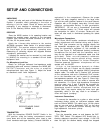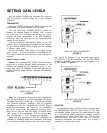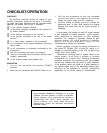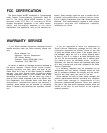
BATTERIES
Careful transmitter battery selection, installation, use
and care will help avoid problems in wireless
microphone use. The most dependable, long-lived bat-
teries at this time are the manganese-alkaline, or
alkaline, types. In addition to offering the longest ex-
pected operating life, they are commonly available.
One small word of caution about alkaline batteries:
they are not all the same size. Make certain the battery
you buy will make contact inside the battery compart-
ment.
Nickel-cadmium (nicad) batteries can save money
through their rechargeability, but the tradeoff is in
shorter expected life per charge. In addition, forgetting
to recharge can be disastrous.
MANUFACTURER
& NO.
VOLTS
Another major consideration in nicads is that of
operating voltage. The “heavy-duty” 8.4-volt nicads are
satisfactory for transmitter use, but the “9-volt-size”
nicads commonly found in stores are only 7.2 volts and
will not provide satisfactory wireless performance.
Mercury batteries in the “g-volt-size” are also actually
8.4 volts. However, their discharge characteristics are
such that they will yield between 10 and 15 hours of
operation with the transmitter.
Carbon-zinc batteries are the least useful for transmit-
ter operation. Their low cost is more than offset by their
extremely short operating and shelf life. Although the
“heavy-duty”’ (HD) carbon-zinc types offer better low-
temperature performance and service capacity at
moderate to high current drain, they will not offer ap-
preciably better transmitter performance than standard
carbon-zinc batteries.
Although battery operation is inhibited at low
temperatures, storing batteries at low temperatures will
increase their shelf life. They should be sealed in bags
and, when ready for use, allow to warm up to room
temperature (never heated!). Cold-stored batteries
should be used as soon as possible after bringing to
room temperature.
Battery life is shortened by high-temperature storage
such as on amplifiers or in vehicles exposed to direct
sunlight.
RECOMMENDED RANGES
The battery should be removed if the transmitter
malfunctions, or if it is to be stored for a long period.
Most batteries have a protective jacket, but partly or
completely exhausted batteries are more prone to
leakage.
Do not attempt to recharge replaceable (primary) bat-
teries using “chargers”, heat or other methods. This may
cause leakage or explosion. Do not disassemble bat-
teries or dispose of them in fire.
BATTERY TYPE
Alkaline
Mercury
Nickel-Cadmium
Carbon-Zinc
(Heavy Duty)
Bright Star 7590
Duracell MN1604
ESB A1604
Eveready 522
IEC 6LF22
NEDA 1604A
Panasonic 6AM6
Radio Shack
23-553
Ray-O-Vac A1604
U.S. Military
BA3090
Varta 4022
Burgess H146X
Duracell TR146X
Eveready E146X
NEDA 1604M
Panasonic TR146
US. Military
BA1090/U
SAFT PS-9
Varta TR7/8
Duracell M1604
Eveready 216
Ray-O-Vac 1604
Radio Shack
23-464
Duracell
M1604HD
Eveready 1222
Ray-O-Vac D1604
Radio Shack
23-583
9.0
8.4
8.4
9.0
9.0
EXPECTED LIFE
6 to 7 hours
10 to 15 hours
1-1/2 to 2 hours
per charge
1 hour
1 hour
Carbon-
Alkaline
Mercury Zinc Nicad
Temperature
0° to 38°C
4° to 54°C 7° to 32°C
-20° to 45°C
(32° to 100°F)
(40° to 130°F) (45° to 90°F)
(-4° to 113°F)
Shelf Life (room 30 months 30 months
6 to 12
10 to 80 days
temperature; to
months
80% of capacity)
14


















